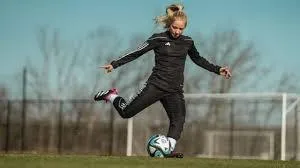
Clicky Hips in Teen Athletes: Causes, Solutions, and How Physiotherapy Can Help
Hip health at any age is crucial for overall mobility, function and athletic performance.
In active teenage girls there is a common condition known as "clicky hips", can cause concern and decrease participation in exercise and sport. It is commonly called female adolescents.
"Clicky hips," a term used to describe a snapping or popping sensation in the hip joint that may or may not be associated with pain or a feeling of stiffness. Medically it is known as Snapping Hip Syndrome (SHS) and can be classified into different types based on the underlying cause.
In this blog, we will explore the main types of SHS and discuss how physiotherapy can effectively manage these issues to get our teenage girls out doing the activities they love.
Main Types and Causes of Snapping Hip Syndrome
External Snapping Hip
External snapping hip is characterised by a snapping sensation felt on the outside of the hip. This occurs when a tendon or band of tissue on the outside of the hip snaps over the hip bone. This type of SHS is often seen in athletes who perform repetitive hip movements, such as runners and dancers. It is commonly caused by weakness of the muscles on the side and back of the hip.
Internal Snapping Hip
Internal snapping hip occurs when a tendon inside the hip snaps over bony structures in the pelvis. This type of SHS is typically felt in the groin area and can be exacerbated by activities involving repetitive high force hip flexion, such as kicking or sprinting. This is characterised by a very dominant hip flexor muscle and possibly slightly mobile hip joint such that the hip tends to sit slightly forward in its socket (rather than being in the centre).
Intra-articular Snapping Hip
Intra-articular snapping hip is less common and involves a catching or locking sensation within the hip joint itself. This can be caused by small loose bodies or other damage within the joint. Intra-articular SHS is often associated with pain. This can occur for many reasons but often slowly develop over a long time period and often with external or internal snapping hip syndrome symptoms previously. It is suggestive of the hip not being optimally positioned and supported with repetitive and/or high force movements over a longer time period. Some people are just more prone to intra-articular conditions due to genetics or other lifestyle factors.
How Physiotherapy Can Help
Physiotherapy plays a vital role in diagnosing and treating the different types of SHS in active female adolescents. Here’s how:
Comprehensive Assessment
A thorough assessment by a physiotherapist is the first step in identifying the underlying causes of clicky hips. This includes a detailed history which will also include current and past activity or exercise loads. We will also ask about general health, growth and development and any early childhood history of hip or joint issues. This information will give us a good starting point for our physical examination. The physiotherapist will evaluate the stability of the hip joint, muscle strength, flexibility, and movement patterns. This will all come together to give a diagnosis and will then guide the best management options.
Personalised Rehabilitation Programs
Based on the assessment, the physiotherapist will develop a rehabilitation program tailored to the individual's specific needs. This program typically includes:
- Strengthening Exercises: Targeting weak muscles, particularly those on the side and back of the hip, to improve hip control.
- Stretching/Releasing Exercises: Focusing on gripping muscles, such as the hip flexors and outer hip band (ITB), to reduce tension.
- Neuromuscular Training: Enhancing control and coordination to improve overall hip joint function and stability.
- Functional Training: Incorporating sport-specific exercises to ensure a smooth transition back to regular activities and prevent re-injury. This includes drills that mimic the movements she the adolescent will perform in their sport or activity.
Manual Therapy
Manual therapy techniques, such as joint mobilisations and soft tissue massage, can help improve joint mobility, reduce muscle tightness, and alleviate discomfort associated with clicky hips.
Education and Lifestyle Modifications
Educating about the condition, proper biomechanics, and the importance of a balanced training regimen is crucial. The physiotherapist may also recommend modifications to activities or training routines to prevent overuse injuries.
Conclusion
By focusing on evidence-based practices and personalised care, physiotherapists can make a significant difference in the lives of young athletes, helping them overcome clicky hips and maintain an active, healthy lifestyle.
Ask a question of Vital Core Physiotherapy
Fill in the form to request a Call From Our Team
One of our team will call you for FREE and answer any questions or concerns you may have about your condition
© 2023 Vital Core Physiotherapy





